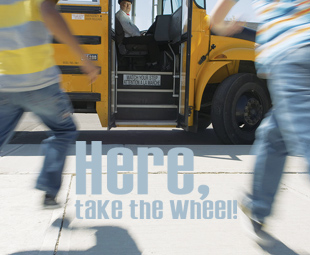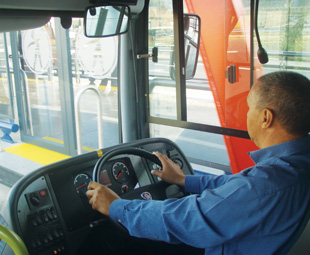Here, take the wheel

With the increasing number of bus accidents pointing to high levels of driver incompetence as a primary cause of road deaths, STUART MOIR investigates the effectiveness of driver training. It has been projected that by 2020, road traffic deaths will rise by 60% worldwide and a staggering 80% in Africa. According to Professor Karl Peltzer, director of a programme exploring the social aspects of HIV/Aids and health, research shows that pedestrians are the most frequently injured road users in Africa, with passengers the second-most vulnerable. Drivers account for only a small share of road fatalities.
“Human error, including speeding, alcohol and drug abuse, and poor driving standards, are the principal factors contributing towards road fatalities,” says Christopher Crooks, area training manager for Scania South Africa. He adds that many bus, taxi and truck drivers don’t have the correct licence to drive the vehicles for which they are responsible, if indeed they have any licence at all. “In addition, drivers often work long hours and start off their day exhausted,” explains Vic Oliver, FOCUS columnist and industry expert. “Drivers push themselves well beyond their physical capabilities and unfortunately do fall asleep at the wheel,” he reveals.
Long hours have always been a concern for drivers in the commercial and public transport sectors. As Crooks comments, even when bus drivers pause at a scheduled stop they are still on duty, whether they are stopping to allow tourists to sight-see or dropping fans off at a stadium. To avoid theft and vandalism, drivers may be required to sit in their vehicles under uncomfortable conditions for hours at a stretch. They then drive on, having had very little, or no rest at all. According to Oliver, bus companies that overwork their drivers to maximise drive time are effectively putting profit before the safety of their passengers.
Yet Dirk Koekemoer, team leader of driver training at Scania, believes that it is not long hours alone that are to blame for poor driving standards. According to him, many bus drivers have simply not been trained in skills relevant to handling such large, heavy vehicles. “Bus drivers often start off as taxi drivers,” he says. “When they move on to driving big buses, it’s difficult for them to get used to the size of the vehicle and its stopping distance requirements.”
Scania is responsible for training drivers for Bus Rapid Transit (BRT), an important component of an improved public transport system nationwide that will be accessible, affordable and reliable. “With BRT, there will be a bus at each station every three minutes so that passengers never have to wait long,” says Klaas Makhubela, a driver trainer for Scania. “Our buses also have their own dedicated bus lane on most of the routes, so traffic is reduced greatly,” he adds.
 Unfortunately, however, public confidence in the bus industry has been significantly undermined in recent years by a dramatic increase in the number of bus accidents. The Moloto road north of Pretoria has become particularly notorious in this regard, receiving a great deal of media attention as a result. In January of this year alone, 87 people were hurt when a bus overturned on Moloto Road. Because the majority of accidents occurring on the road are speed-related, Makhubela believes that drivers need to be educated on the implications of load and speed for stopping distances; a concern that also applies to the drivers of heavy trucks. “Although the training we provide at Scania focuses on K53, we encourage our drivers to implement what they have been taught constantly while driving,” he says.
Unfortunately, however, public confidence in the bus industry has been significantly undermined in recent years by a dramatic increase in the number of bus accidents. The Moloto road north of Pretoria has become particularly notorious in this regard, receiving a great deal of media attention as a result. In January of this year alone, 87 people were hurt when a bus overturned on Moloto Road. Because the majority of accidents occurring on the road are speed-related, Makhubela believes that drivers need to be educated on the implications of load and speed for stopping distances; a concern that also applies to the drivers of heavy trucks. “Although the training we provide at Scania focuses on K53, we encourage our drivers to implement what they have been taught constantly while driving,” he says.
According to Koekemoer, although BRT’s verification process and screening system are aimed at ensuring that every driver not only has a valid driver’s licence but also a professional driving permit (PrDP), this is not enough. Apart from completing an application form and paying the required fee, all that is needed to get a PrDP is a set of photographs, a medical examination and an eye test. “Just because drivers have the paperwork doesn’t mean they can drive well,” he says. “We need to change old habits and re-educate people to drive properly.”
Crooks agrees. “Nothing about having a PrDP makes you a professional driver. At Scania, we have an accredited training facility that also offers product-specific training,” he adds, emphasising that mandatory, relevant driver training is the only way forward. Scania’s instructors and moderators are skilled at ensuring that all trainees are educated on more than just driving the vehicle. “We offer an element of defensive driving and teach drivers to anticipate uncertain circumstances,” Crooks explains. They are also responsible for route planning and basic maintenance. Scania’s driver training programme has released 160 trained drivers and plans to release a further 50 by the end of April, with the next roll-out in May. It is an important step in the process of formalising and, ultimately, regulating bus driver training in a system where, currently, there is not even a professional driving academy for bus and truck drivers.
The provision of relevant, accredited driver training on a wider scale could address a number of important issues. By enhancing the status of bus and truck driving as a career, it could help to attract younger drivers to an industry where, according to Koekemoer, the average age of drivers is currently between 40 and 60 years. Not only would this create a bank of top quality bus drivers; it would provide incentives for well-trained and experienced drivers to themselves become trainers later on in their careers.
At another level, the tedious nature of long-distance driving and the use of rewards-based wage systems by some operators, encouraging drivers to push themselves beyond normal physical limits, could explain the high levels of substance abuse among bus and truck drivers. This is an issue of particular concern to Oliver, and Koekemoer concurs. “There is definitely a need for drivers and members of the public to be aware of these dangers,” he says. “Not only do we need to monitor driving standards; we need to ensure that drivers are not abusing themselves or their vehicles.”
A range of innovative products and systems is now available aimed at promoting and reinforcing positive driver behaviour and improving the driver recruitment process. Gert Pretorius, managing director of MiX Telematics, says, “We have seen major improvements in driver safety and vehicle utilisation, as well as a significant reduction in fuel and vehicle theft based on technologically advanced fleet management systems.” One such system available from MiX Telematics allows operators to monitor whether a particular style of driving falls within “green band” specifications, so that corrective measures can be taken to rectify potentially problematic driving habits.
“The introduction of the new Administrative Adjudication of Road Traffic Offences (Aarto) Act will also help combat dangerous driving,” says Koekemoer. “Bus drivers, like other vehicle users, will obtain demerits for unlawful driving activities,” he explains. “This will result in drivers losing their licences if they lose too many points.” Bus drivers already have to take personal responsibility for speeding by paying any fines they may receive; something which tends to suggest that no matter how many industry players become involved in initiatives aimed at improving overall bus driving safety standards, the buck eventually stops with the man behind the wheel.
Published by
Focus on Transport
focusmagsa




